Month: March 2023
How to Build A Custom Learning Management System
What is an LMS?
A learning management system, or LMS, is a web-based system that automates the learning process for employees, students, and other users. With a learning management system, you can gather all your learning materials in one place and make them available to all learners in just one click. You can even create different groups of learners according to their functions or job positions.
In an LMS, you can assign learners a single course, a test, or a whole series of materials called a learning path. You can then easily track each learner’s progress to encourage the leaders and help the team to develop faster. Today we’ll talk about how to create your own learning management system.
A wide range of organizations from high schools to corporations can benefit from using a learning management system to reduce expenses for things like:
- Classroom rentals
- Transport and accommodation
- Instructors’ salaries
- Printouts of learning materials
The right LMS helps you save time, set unified learning standards, and regularly assess and develop employees’ knowledge.
LMS market trends and statistics
The Learning Management System (LMS) market has experienced significant growth over the last decade, and this trend is expected to continue in the coming years. Schools, universities, and organizations increasingly adopt LMS platforms to manage and deliver online training and education.
According to MarketsandMarkets, the global LMS market is expected to grow from $4.06 billion in 2020 to $11.34 billion by 2025, at a CAGR of 22.6% during the forecast period. This growth can be attributed to the increasing demand for personalized learning experiences and the growing adoption of e-learning in various industries.
The COVID-19 pandemic has boosted the LMS market as organizations and educational institutions rapidly shifted to online learning.
Another report by eLearning Industry states that the LMS market is expected to reach USD 22.4 billion by 2023, growing at a CAGR of 24.7% from 2017 to 2023. The report also highlights the increasing trend of gamification in e-learning and the importance of mobile learning in the LMS market.
North America is the largest market for LMS, followed by Europe and Asia Pacific. A report by Technavio states that the North American LMS market is expected to reach USD 4.29 billion by 2024, growing at a CAGR of over 22% during the forecast period.
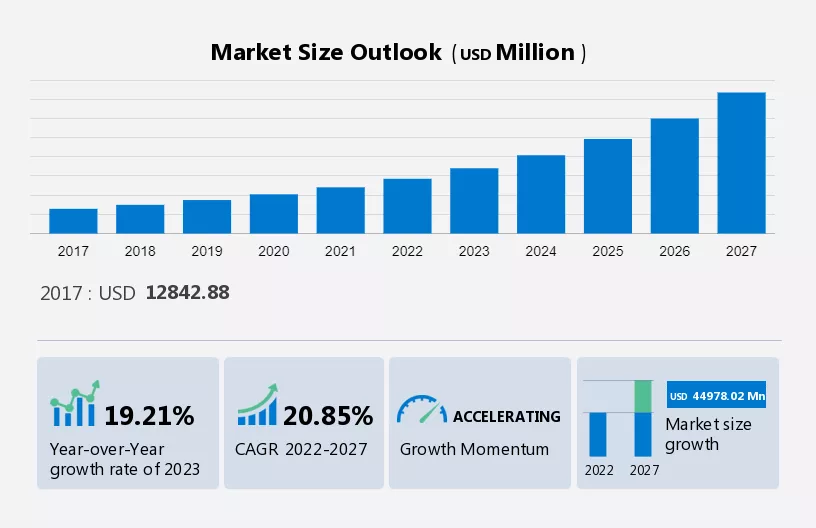
The COVID-19 pandemic has boosted the LMS market as organizations and educational institutions rapidly shifted to online learning.
The LMS market is expected to grow significantly across the world, and two of its biggest trends right now are gamification and mobile-first experience.
Types of learning management systems
There are many different types of learning management systems. You should conduct research and decide what type of LMS you want to develop. Here are the main types:
- Internal corporate LMS
- Internal school/university LMS
- LMS software as a service
Each type of learning management system has different features and different business analysis processes.
Internal corporate LMS
Some companies choose a custom LMS for internal use. For the most part, the reason is that many SaaS learning management systems have limits on customization. If you plan to use an LMS for teaching your employees unique processes, finding a system that can cover those processes may be hard. Additionally, when it comes to security, a custom learning management system is generally better than a third-party solution.
On the other hand, if your company doesn’t require unique processes and your learning materials don’t include any confidential data, it might be best to opt for a SaaS LMS, as it will be cheaper and easier to implement.
Internal school/university LMS
Schools and universities don’t need their own custom LMSs. These institutions usually don’t use private information in learning materials, and customization isn’t that important for them. For schools and colleges, the cost of building a custom learning management system can be too high.
However, times are changing. With quarantine, servers of SaaS learning management systems like Google Classroom are heavily loaded. It might be time for some changes, and maybe big institutions will consider investing in developing their own LMSs.
LMS software as a service
If you want to build a learning management system that you can offer as a service to businesses or schools, you should choose a niche. The market is full of great LMS solutions, and you’ll need to stand out from the crowd. It’s very important to create your own LMS with a unique value proposition.
How to come up with your LMS idea
As the demand for learning management systems grows, so does the number of LMS solutions. How do you come up with a unique idea for an LMS so that you can find your place in the market and withstand the competition? Here are a few tips.
Solve real problems
People don’t really care about ideas or innovations; they need to solve their issues and make their lives easier. Originality for the sake of originality becomes old very fast, so make sure your product solves a problem and does it better than competitors.
Know your users
Determine the target audience for your LMS. This could be students, professionals, businesses, or any other group of people who could benefit from online learning. The better you know your users, the better you can understand their needs and pains.
Conduct surveys, interviews, and focus groups with your target audience to get feedback on your LMS idea. This will help you understand the needs of your users and ensure that your LMS meets their needs.
Hop on the latest trends
Trends come from demand; that’s why it’s important to consider them when thinking of launching a new product. As I already stated, gamification and a mobile-first approach are the two biggest trends in today’s LMS market. By investing in mobile development and adding gamification elements to your app, you can compete with older products that haven’t done this yet.
Study the market and identify gaps
Research the existing LMS solutions in the market and identify the gaps you could fill. Look for areas where the existing solutions are lacking and where you could provide a better solution.
Create a business plan
Develop a business plan that outlines your LMS idea, including the target audience, the features you plan to offer, and the pricing model. This will help you determine the feasibility of your LMS idea and identify any potential roadblocks. Create two scenarios, an optimistic and a pessimistic one, to find the perfect balance between your ambitions, resources, and risks.
Develop an MVP
It’s essential to validate your idea in real market conditions. Develop an MVP that includes the basic features of your LMS. This will allow you to test your idea with a small group of users and get feedback on your product.
However, don’t make your MVP overly simplistic. Otherwise, you won’t be able to attract users. Include that one killer feature that makes you different from competitors.
Iterate and improve
Gather feedback from real users and don’t get too attached to your ideas or hypotheses. Be ready to change and improve your product with each iteration, and do it at every stage of your LMS development and growth.
In summary, to come up with a great LMS idea, you need to:
- understand your target audience and their needs
- conduct the market and user research
- consider market trends
- test your product idea in real market conditions
- make changes based on experimentation and constant feedback
Basic features of a learning management system
When building an LMS, you should research what features you need to build. Below are the key features of a learning management system.
Course builder
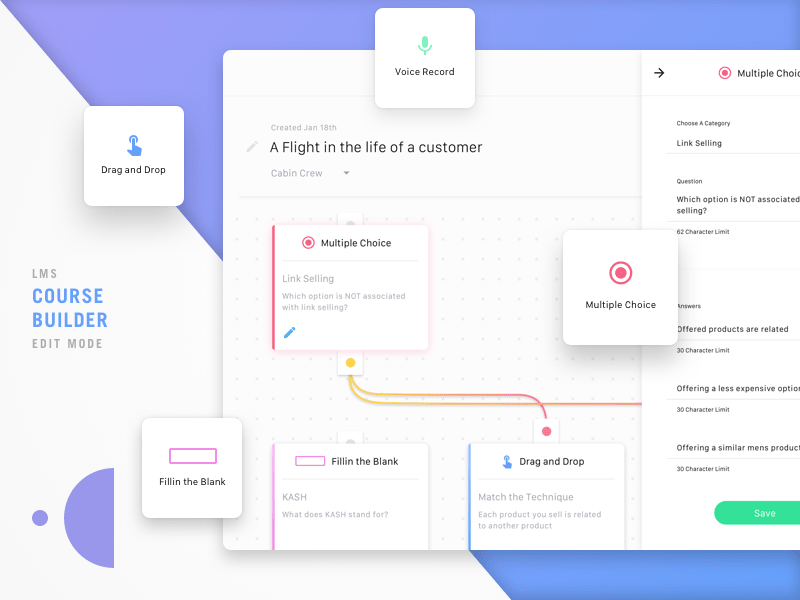
This feature is considered the core of a learning management system. It allows users to create courses for training within a company or school. A course builder has to be able to build courses around various topics and create quizzes to test learners.
Content management
Content is essential for a website or application, and it’s also quite important for a customizable learning management system. When building your own LMS, note that the content management feature is responsible for the content that will be used for training employees.
Skills assessment and testing
A learning management system should be equipped with a tool to manage and measure skills that users acquire. Assessing skills is very important, as it helps you see whether training is effective. Assessing skills can take the form of quizzes, tests, and assignments.
Progress tracking
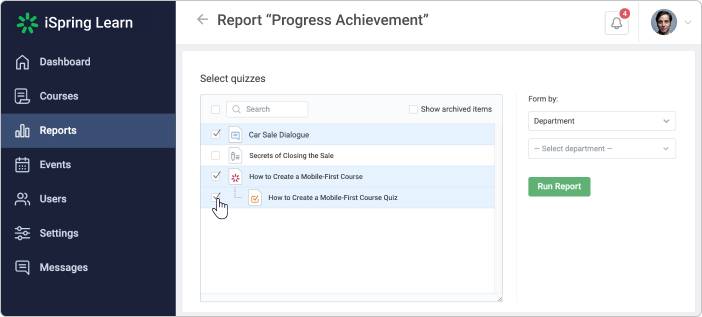
A quality learning management system should allow you to track learners’ progress. It should show the number of quizzes learners have taken, how long it takes them to complete those quizzes, and the number of tasks learners have completed.
This feature includes the following:
- Achievements. Track the learner’s progress with achievement rewards.
- Statistics. Track users’ progress by analyzing statistics.
- Surveys. Create surveys to find out what your users think about the learning management system.
Social structure
When building a customized learning management system, you should focus on making the learning process easy for users. You can achieve this goal by giving users a community where they can share their experience. Consider adding a live chat or a forum where users can discuss things and get quick answers to their questions. This can make communication and information sharing easier for people within your company.
Group creation
No matter if they consist of school classes or teams of new employees, groups are an essential part of a learning management system. A group creation feature helps teachers organize course materials and distribute them to learners. Learners can also use groups to communicate among themselves, collaborate, and help each other.
Calendar

A calendar lets you set deadlines for learners. This feature is quite important if a group needs to study at a set schedule. A calendar feature can even be useful for individual learning — for example, to track progress and the speed at which a user learns.
Library
A library organizes content that can be reused for different courses It can also store supplemental content that might be helpful for students. The library in a learning management system should be able to support different kinds of content like text documents, PDFs, and audio and video files. Don’t forget to implement a filtering system for fast search.
Mobile support
Usually, learning management systems are created for web use. But consider making your LMS accessible on all kinds of devices to provide users with access to your LMS throughout the day. Lots of people prefer to use their mobile devices over computers. Mobile support also provides learners with the flexibility to take courses when it’s most convenient for them.
Notifications
A learning management system should provide real-time updates on lessons and exams.
An LMS can send notifications in the form of:
- Simple text messages
- Images
- Action buttons
Security
Never overlook the security of your learning management system. When developing an LMS, make sure that only authorized people can edit or remove courses. Security measures can prevent you from losing business data and exposing users’ private information.
Top technologies for LMS development
The world of programming offers countless technologies that you can combine to get the results you want. Here are the most common technologies that are suitable for LMS development.
Backend:
- PHP
- Python
- Ruby on Rails
- Java
Front-end:
- React
- Angular
- Vue.js
Mobile technologies:
- Swift (native iOS)
- Kotlin (native Android)
- Flutter, React Native (both Android and iOS)
Databases:
- MySQL
- PostgreSQL
- MongoDB
Web servers:
- Apache
- Nginx
Cloud platforms:
- Amazon Web Services (AWS)
- Microsoft Azure
- Google Cloud Platform (GCP)
Content authoring tools:
- Adobe Captivate
- Articulate Storyline
- Lectora.
Learning analytics tools:
- Moodle Learning Analytics
- Blackboard Analytics
- Edvance360.
These are just a few examples of technologies you can use for your LMS. It’s best to consult with experienced developers so that they can create a perfect tech stack for your needs in terms of performance, scalability, and cost-efficiency.
How to create a learning management system
Let’s find out how to build a learning platform.
Create an LMS project plan
A successful learning management system should be based on a well-structured project plan. Here’s how to create LMS project plan.
Start making a plan by asking these basic questions:
- Why am I creating an LMS?
- What problems is my company or organization facing and how will a learning management system solve them?
- Who will build the LMS?
- Who will implement the LMS?
- How much do I plan to invest in LMS development?
There are more questions to consider when developing a project plan, but these are the most important ones that can give you an idea of where to start.
Choose the core features of your LMS
Make a list of valuable features for your learning management system. Don’t forget to research the market to find out what features your target audience will need.
Note that the market is full of great solutions, and to stand out, you’ll need to come up with a unique value proposition.
Hire an LMS development company
To help you build your learning management system, hire a professional LMS development company. The first phase of development will include business analysis, developing a technical specification, estimating the development cost, and planning the project. Before diving into the actual development, you and your team should create an app development workflow, choose the main features for the app, and design the app concept.
Make The Right Tech Stack Choices
The tech stack can create a project or destroy it. It is also a determining factor when budgeting for LMS development. With that in mind, we present you with a perfect development workflow and technology stack that you can use while developing your LMS platform.
| Database | MongoDB, MySQL, PostgreSQL |
| Web development framework | Laravel, AngularJS, ReactJS |
| Payment Gateway | Stripe, PayPal |
The best thing about hiring an experienced development partner is the range of choices you get.
Build an MVP for your LMS
Start by creating a minimum viable product (MVP) of your learning management system. By first launching an MVP and testing its technical and business performance, you’ll be able to find out what users like and don’t like in your app. Then you’ll be able to consider their feedback and improve your app.
Get an example of the Discovery Phase documentation for your digital project
Top 4 learning management systems in 2023
Here’re the top 4 best LMS websites in 2023:
CYPHER LEARNING LMS
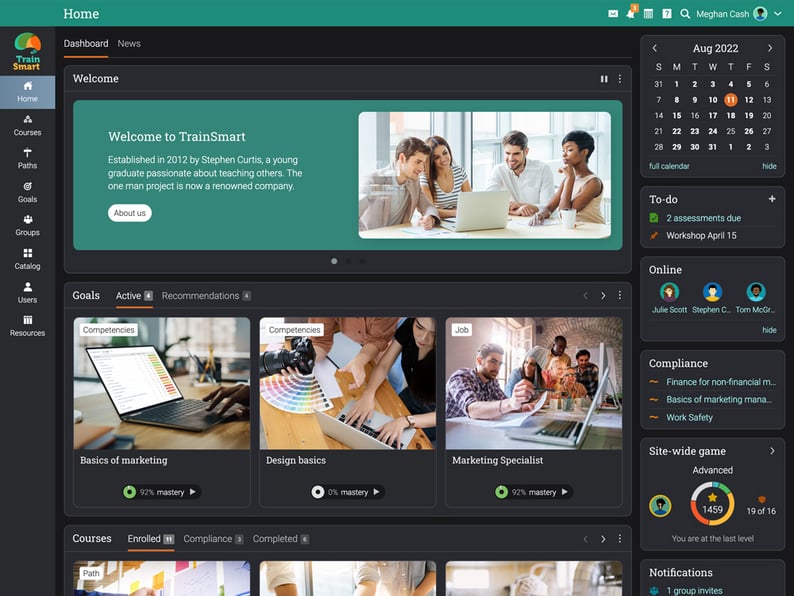
CYPHER LEARNING provides learning management systems for businesses, schools, and universities. Their LMS products are designed to deliver online learning and training experiences that are engaging, effective, and customizable.
CYPHER LEARNING offers two main LMS products: MATRIX and NEO.
MATRIX is an all-in-one LMS that includes features such as course management, gamification, social learning, and analytics. It’s designed for businesses and schools of all sizes, allowing users to create and deliver online courses, track employee progress, and manage certifications.
NEO is a more specialized LMS that’s designed for schools and universities. It includes features such as grading, assessments, and collaborative learning tools. NEO also offers a variety of customization options, allowing schools to tailor the platform to their specific needs.
CYPHER LEARNING’s LMS products are known for their ease of use, robust feature sets, and ability to support a wide range of learning and training needs.
Absorb LMS
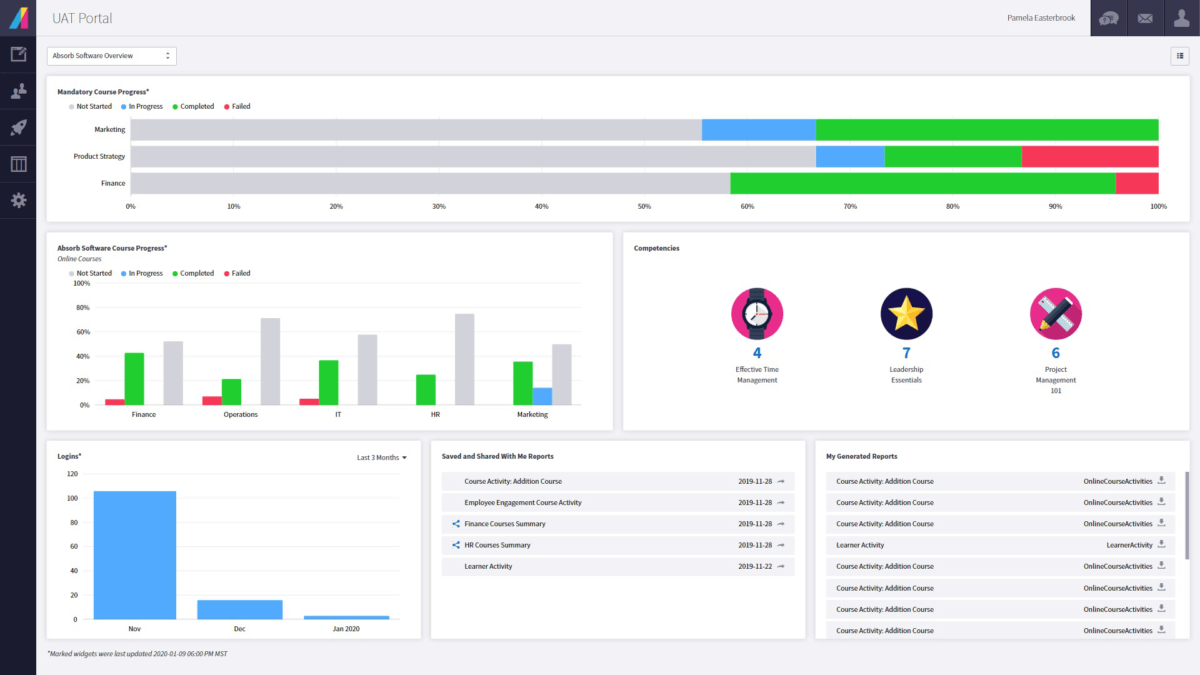
Absorb LMS is a cloud-based LMS designed to deliver online training and education programs for businesses and organizations of all sizes. It offers a wide range of features and tools to create, manage, and track online training courses and programs.
Some of the key features of Absorb LMS include course authoring, certification and compliance management, gamification, social learning, eCommerce functionality, and reporting/analytics. The platform is also mobile-friendly, allowing users to access courses and training materials from any device.
Absorb LMS has a great user-friendly interface. It also offers a variety of integrations with other software tools, such as Salesforce, Microsoft Teams, and GoToMeeting.
TalentLMS
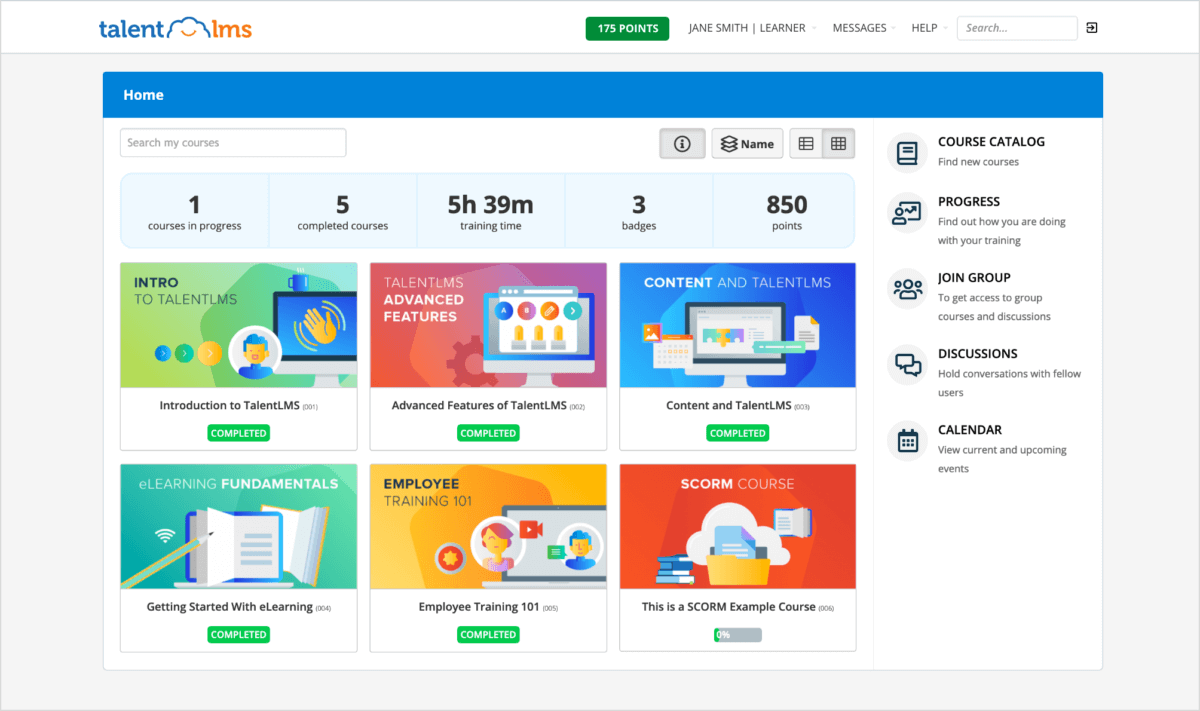
TalentLMS is a cloud-based learning management system whose goal is to enhance online learning and training. It provides users with analytics and can be customized to meet their needs. TalentLMS can be accessed from both iOS and Android devices, is content-friendly, and provides users with SCORM and Tin Can (xApi) compliance, assessment engines, survey engines, learning paths, and a file repository.
Pricing: Free for 5 users, $29/month for up to 25 users, $99/month for up to 100 users, $199/month for up to 500 users, and $349/month for up to 1000 users
iSpring
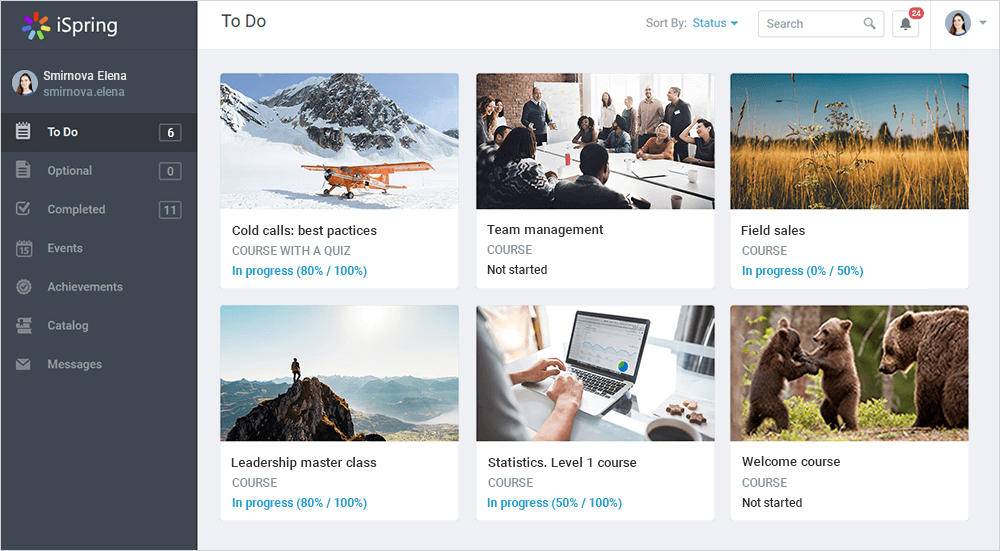
iSpring Learn LMS is created for businesses that need help in setting an LMS for their organization. The most prominent features of iSpring include course authoring, video lectures, quizzes, surveys, reporting and analytics, social learning, and eCommerce functionality. The platform also supports blended and mobile learning, allowing users to access courses and training materials from any device.
The best thing about iSpring is their support: the team responds to 83% of support cases within two hours.
LMS monetization
Learning management systems usually adopt a paid monetization model. This is a perfect option because it avoids interrupting users’ studies with annoying ads. You have two main options for monetizing a learning management system:
- Paid software with a trial period. Paid learning management systems are widespread. But such LMSs face strong competition from free and freemium options like Google Classroom. To succeed with a paid model, you’ll need to build a professional LMS with high-quality features and a compelling value proposition.
- Freemium model. With this model, users can download your app for free. They can then pay to upgrade their account or use premium features. Extra features can be very useful, but they’re not part of the core functionality.
Cost of learning management system development
The cost of developing an LMS depends on multiple factors like:
- the system complexity
- the feature scope
- the tech stack
- design complexity
- number of platforms
- the hourly rate of your development team
The system complexity and the hourly rate are the two most influential factors that determine your LMS development cost. The hourly rates vary greatly depending on the location of your team. The system developed in the US can cost 4x more than the same system built in Ukraine due to local hourly rates.

According to Clutch, the hourly rate for development teams in Ukraine can be as low as $50, while teams in the US and Western Europe can charge up to $200 per hour.buil
According to the eLearning Industry, the cost of developing a custom LMS can range from $40,000 to $250,000. If you decide to add gamification, social learning, and other complex features, naturally, it will increase the price.
Mobindustry expertise
How can Mobindustry help you with creating a learning management system? Our team is great at combining tech and business expertise and building products that solve real problems. We can help you at any stage of your custom LMS development journey, from helping you crystallize your idea and suggesting business solutions to developing, optimizing, and maintaining your LMS system.
Most of our clients come to us for a tech consultation and stay for years of maintenance and support.
We’ve worked with multiple ed-tech startups and created e-learning mobile applications, web apps, and platforms. With our tech stack and business knowledge, we can make any idea a reality and also keep our development process cost-effective and transparent.
Quick summary of developing a custom learning management system
Developing a custom learning management system is a long and hard process. But if done correctly, your LMS can become successful and bring a lot of value to you as a business owner.
Key takeaways:
- A well-developed LMS can help you save time, set unified learning standards, and regularly assess and develop employees’ knowledge.
- Learning management systems usually use a paid or freemium monetization model.
- The market is full of great solutions, and you’ll need to stand out from the crowd. It’s important to create your own unique value proposition.
If you want to create a custom learning management system but don’t know where to start, feel free to contact Mobindustry for a consultation.

